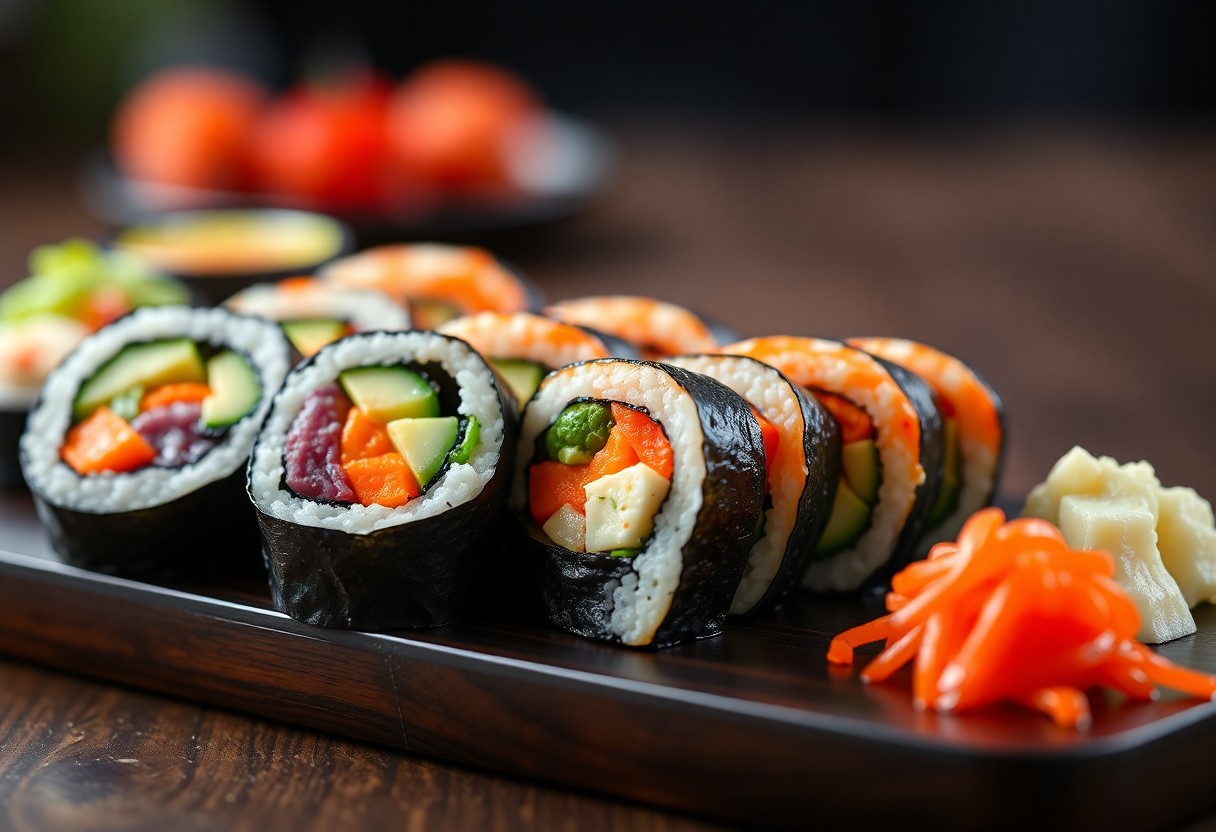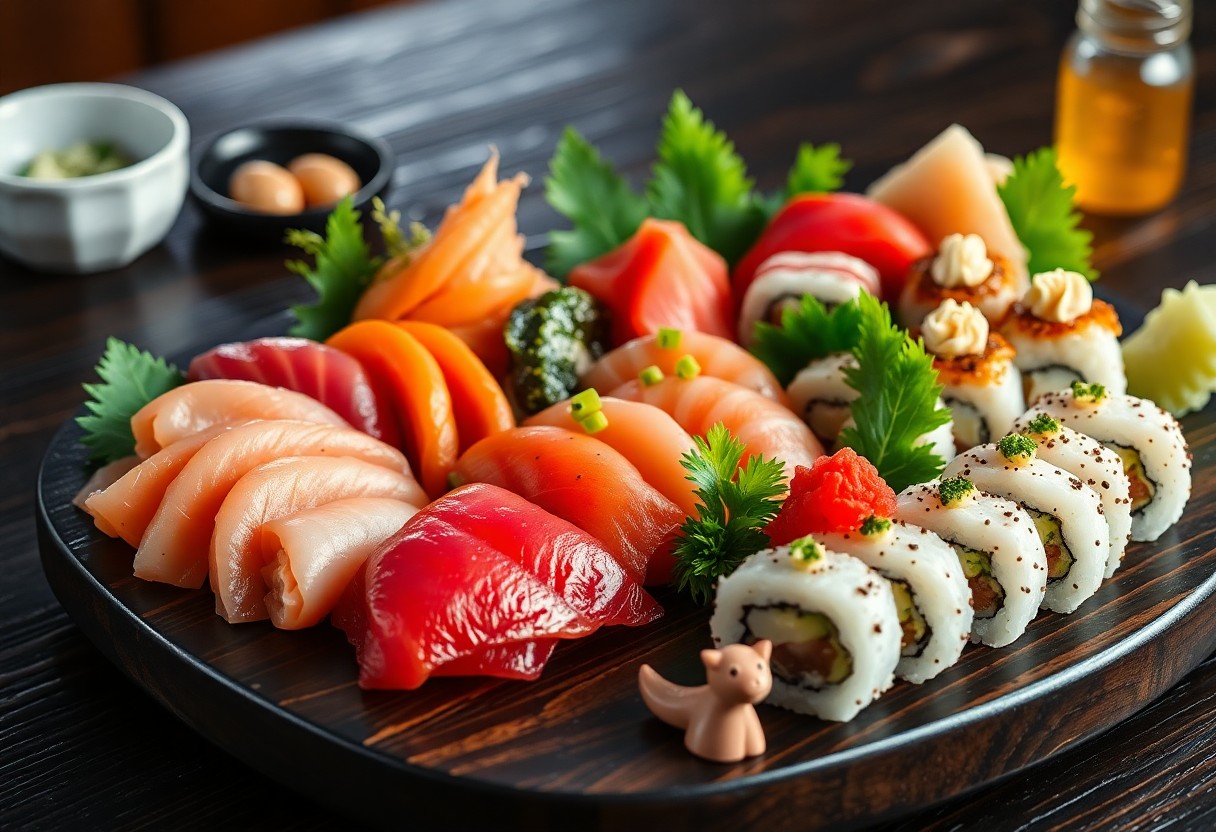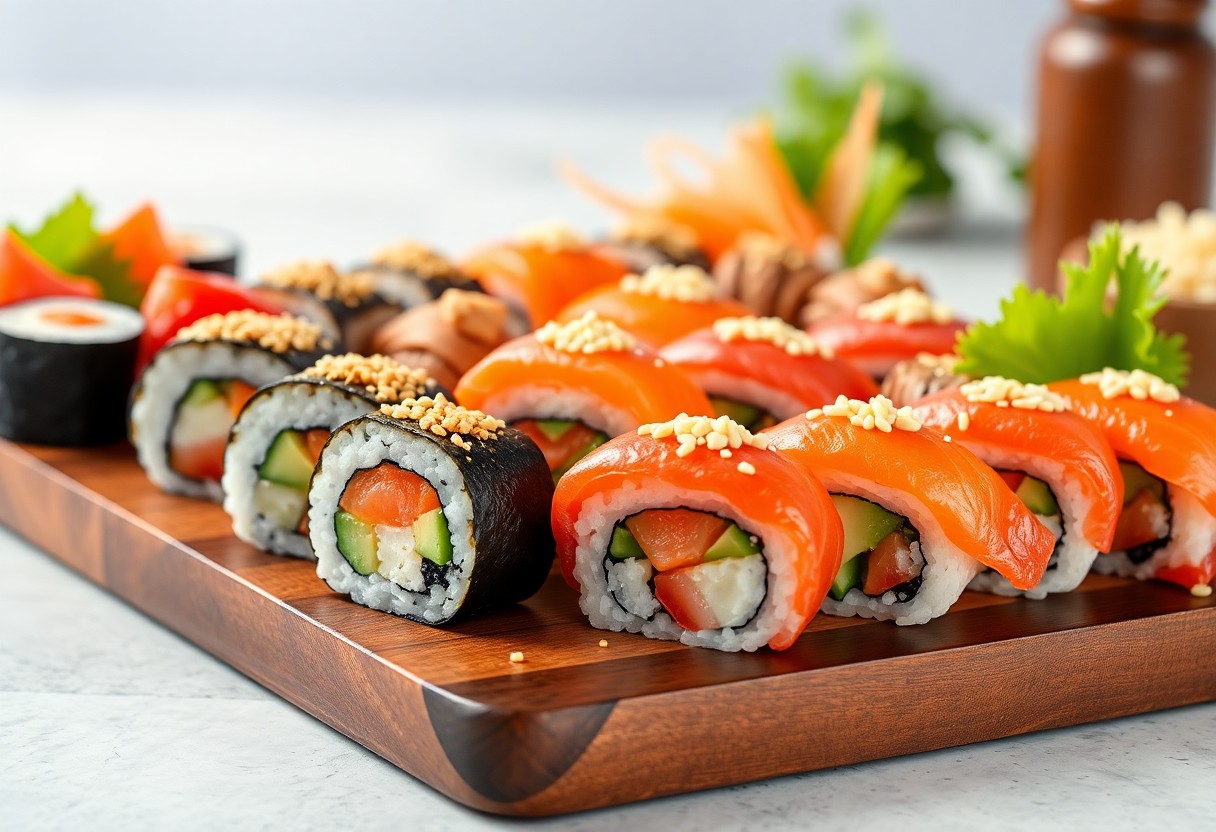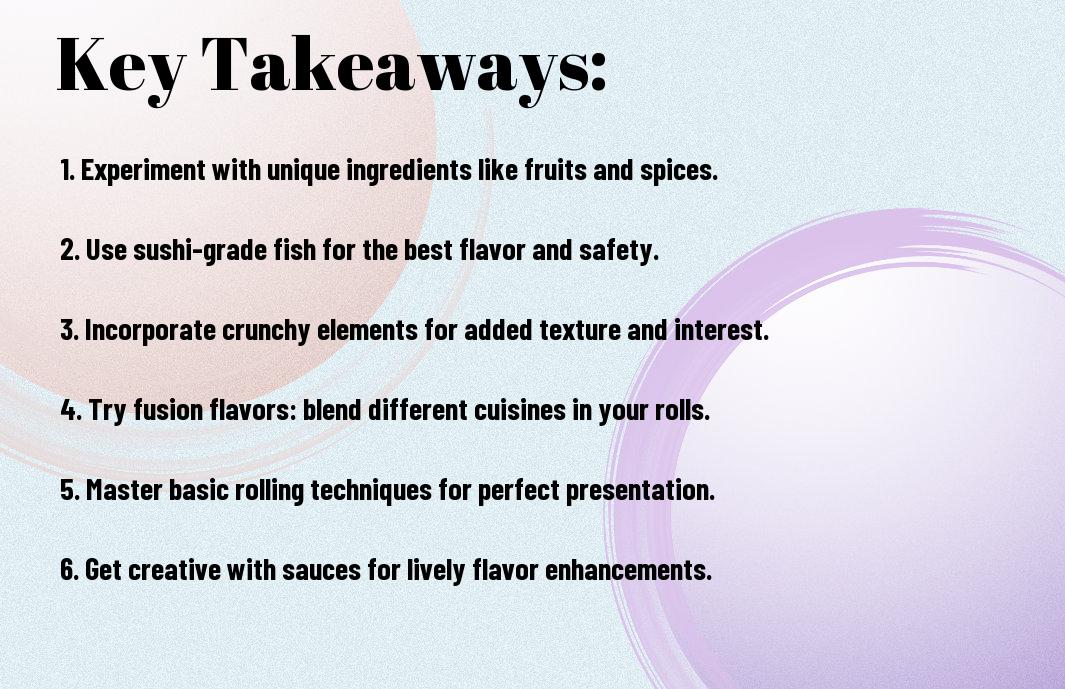You can enjoy the delightful experience of making sushi right in your own kitchen. With these 10 easy sushi recipes, you’ll discover how simple it is to roll your own delicious creations using fresh ingredients and straightforward techniques. Whether you’re a beginner or looking to enhance your skills, these recipes will guide you in crafting perfect sushi rolls, sashimi, and more. Get ready to impress your family and friends with your homemade sushi delights!
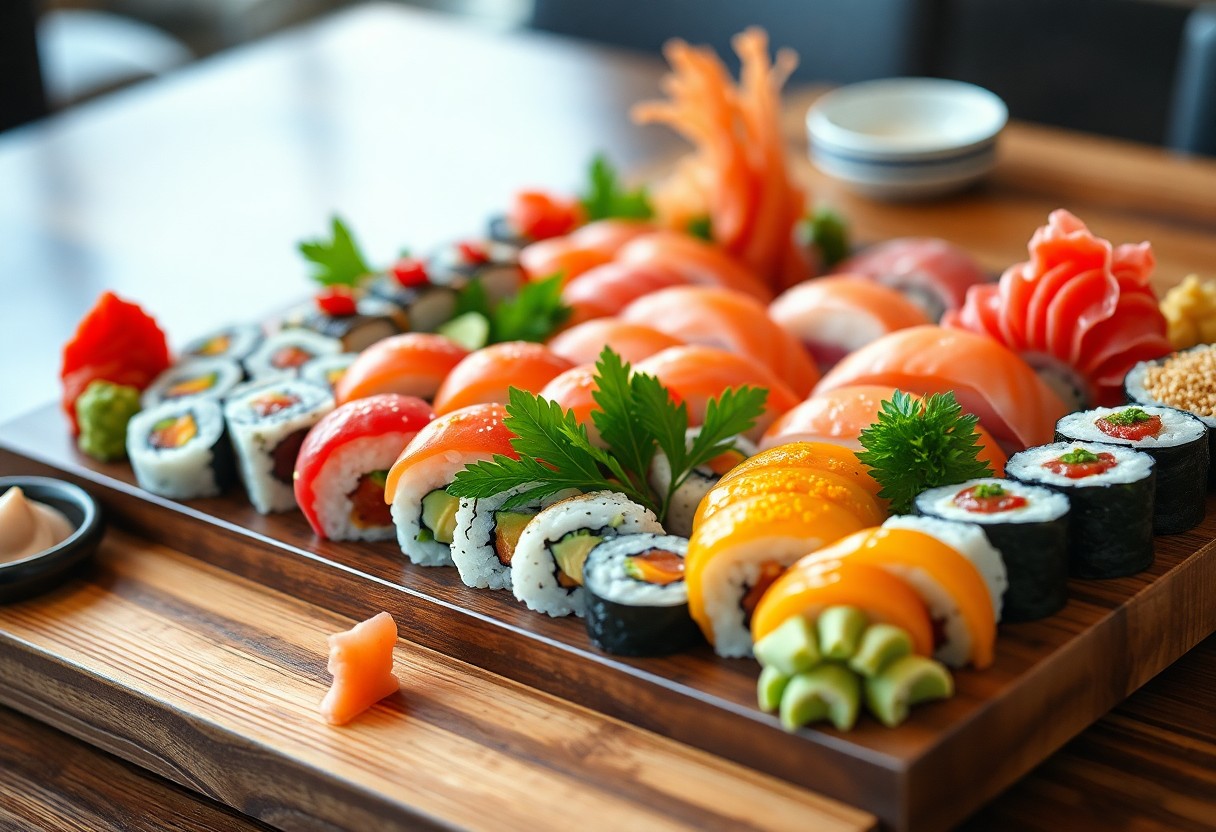
Key Takeaways:
- Variety of Recipes: The article features a range of 10 sushi recipes, including traditional and creative options for all skill levels.
- Ingredients Simplified: Each recipe lists accessible ingredients, making it easy for home cooks to gather what they need.
- Step-by-Step Instructions: Detailed instructions guide you through the sushi-making process, ensuring a successful result.
- Healthy Options: Many of the recipes incorporate fresh vegetables and fish, supporting a balanced diet.
- Fun Activity: Making sushi at home can be an enjoyable group activity, perfect for gatherings or family nights.
Classic California Roll
While sushi may seem daunting, the classic California roll is a delightful and approachable option for home chefs. This sushi roll combines creamy avocado, sweet crab (or imitation crab), and crisp cucumber wrapped in vinegared rice and nori. With its fresh ingredients and uncomplicated preparation, you’ll impress your family and friends with this crowd-pleaser.
Ingredients
Against the backdrop of your kitchen, gather these crucial ingredients to create your California roll: sushi rice, nori sheets, imitation crab meat, avocado, cucumber, rice vinegar, sugar, and salt. A dash of sesame seeds adds a nice finishing touch.
Step-by-Step Instructions
At this point, you should follow these straightforward steps to craft your California roll:
| 1. Cook the sushi rice according to package instructions and season with rice vinegar, sugar, and salt. |
| 2. Place a sheet of nori on a bamboo mat, shiny side down. |
| 3. Wet your hands to prevent sticking and spread a thin layer of rice on the nori. |
| 4. Add a line of crab, avocado, and cucumber along the center. |
| 5. Use the bamboo mat to roll the nori tightly, sealing the edges with water. |
| 6. Slice the roll into pieces and sprinkle with sesame seeds. |
This process might feel tricky at first, but it becomes easier with practice. By following each step and using a bamboo mat for rolling, you’ll achieve tight, uniform rolls. You can customize the filling to suit your taste, incorporating more vegetables or even spicy mayo for extra flavor. Enjoy experimenting with variations as you perfect your homemade California roll!
| 1. Use a sharp knife to ensure clean cuts for a professional finish. |
| 2. Keep a small bowl of water nearby to moisten your hands and knife. |
| 3. Try serving with soy sauce and pickled ginger for an authentic experience. |
Spicy Tuna Roll
Now, let’s investigate the delightful world of Spicy Tuna Rolls. This sushi favorite brings together the rich flavors of spicy tuna and creamy avocado, all wrapped in perfectly seasoned rice and nori. If you’re looking to expand your sushi-making skills, check out this page for 8 Easy Sushi Rolls Recipes You Can Make At Home.
Ingredients
Among the crucial ingredients for your Spicy Tuna Roll are sushi-grade tuna, spicy mayo, sushi rice, nori sheets, avocado, and cucumber. You will also need soy sauce and pickled ginger for serving.
Step-by-Step Instructions
Step-by-Step Process
| 1. Prepare the sushi rice according to package instructions. | 2. Mix diced tuna with spicy mayo to taste. |
| 3. Lay a nori sheet on a bamboo mat, shiny side down. | 4. Evenly spread sushi rice over the nori, leaving a small border at the top. |
| 5. Add the spicy tuna mixture, avocado slices, and cucumber strips. | 6. Carefully roll the sushi, applying gentle pressure. |
| 7. Slice the roll into bite-sized pieces using a sharp knife. | 8. Serve with soy sauce and pickled ginger. |
After gathering your ingredients, follow these simple steps to create your own Spicy Tuna Roll at home. Each action requires a bit of care and precision, so make sure to focus on spreading the rice evenly and rolling tightly for a perfect shape. Enjoy your homemade sushi with soy sauce, complemented by aromatic pickled ginger, enhancing the flavors even more.
Ingredients
| Sushi-grade tuna (finely diced) | Avocado (sliced) |
| Spicy mayo (to taste) | Cucumber (julienned) |
| Sushi rice | Nori sheets |
Vegetable Sushi Rolls
All you need to enjoy delicious, healthy sushi at home is a few simple ingredients. Vegetable sushi rolls are a fantastic way to introduce yourself to sushi-making, and you can customize them with your favorite veggies. Not only are they visually appealing, but they’re also a nutritious option for a light meal or snack. Let’s explore the delightful world of vegetable sushi rolls!
Ingredients
To create your vegetable sushi rolls, gather the following ingredients:
| Short-grain sushi rice | 2 cups |
| Nori seaweed sheets | 4-6 sheets |
| Cucumber | 1, julienned |
| Avocado | 1, sliced |
| Carrot | 1, julienned |
| Soy sauce | For serving |
Step-by-Step Instructions
Across the process of making your vegetable sushi rolls, focus on the following steps to achieve perfect sushi:
| 1. Cook the sushi rice | Rinse, cook, and let it cool. |
| 2. Prepare your filling | Slice the vegetables into thin strips. |
| 3. Assemble your sushi | Place nori on a mat, spread rice, add veggies. |
| 4. Roll tightly | Use the mat to help roll and compress. |
| 5. Slice and serve | Cut into pieces and enjoy with soy sauce. |
Instructions for rolling your sushi require you to lay the nori sheet on a bamboo mat with the shiny side facing down. Spread a thin layer of sushi rice evenly across the nori, leaving an inch at the top free of rice for sealing. Place your julienned vegetables in the center. Tightly grasp the mat and start rolling away from you, pressing firmly to ensure a tight roll. Once you reach the exposed nori, wet it slightly to seal the roll. Use a sharp knife to cut it into bite-sized pieces. Enjoy your homemade creations with soy sauce for dipping!
Salmon Nigiri
Many sushi lovers appreciate the simplicity and elegance of Salmon Nigiri. This classic dish features a delicate piece of fresh salmon over a mound of seasoned sushi rice, creating a perfect balance of flavors and textures. Making it at home allows you to customize the ingredients to your liking while honing your sushi-making skills. Prepare for a delightful experience as you examine this easy recipe that showcases the beauty of fresh seafood.
Ingredients
Behind every great Salmon Nigiri, quality ingredients are vital. You will need the freshest sushi-grade salmon, sushi rice, rice vinegar, sugar, and salt. Optionally, wasabi and soy sauce can be served on the side for added flavor. Having the right tools, like a sharp knife and bamboo mat, will also enhance your sushi-making experience.
Step-by-Step Instructions
One of the best parts of making Salmon Nigiri is the straightforward process. Follow the simple steps below to create this delicious dish:
| 1. Rinse and cook the sushi rice, then season it with vinegar, sugar, and salt. | 2. Slice your salmon into thin, even pieces. | 3. Wet your hands and form small oval-shaped mounds of rice. | 4. Place a slice of salmon over each mound of rice, pressing gently. | 5. Optionally, add a touch of wasabi between the rice and salmon. | 6. Serve immediately with soy sauce for dipping. |
Understanding the art of making Salmon Nigiri involves mastering the rice and fish balance. The quality of sushi rice is paramount as it needs to be sticky enough to hold together but not too dense. When slicing the salmon, aim for uniform thickness to ensure each piece lays beautifully atop the rice. The pressing technique when placing the salmon should be gentle to maintain the fish’s integrity while adhering to the rice. Practice these steps, and you will create an impressive dish worthy of any sushi restaurant.
| Choose the freshest salmon possible for optimal taste. | Invest time in rinsing and seasoning the rice correctly. | Slicing techniques affect presentation and texture. | Serve immediately for the best flavor experience. |
Ebi (Shrimp) Sushi
To create delicious Ebi sushi, you’ll need to master the art of preparing succulent shrimp. This delightful sushi can elevate your culinary skills while impressing your friends and family. If you’re interested in a comprehensive guide, check out How to Make Homemade Sushi Rolls to get started on your sushi journey!
Ingredients
At the core of your Ebi sushi, you’ll need fresh shrimp, sushi rice, nori sheets, and a splash of soy sauce. You can also include pickled ginger and wasabi for an authentic touch. Here is a table outlining the key ingredients:
| Ingredient | Amount |
| Fresh Shrimp (peeled & deveined) | 10 pieces |
| Sushi Rice | 2 cups |
| Nori Sheets | 5 sheets |
| Soy Sauce | To taste |
| Pickled Ginger | To serve |
| Wasabi | To serve |
Step-by-Step Instructions
After gathering your ingredients, follow these simple steps to make Ebi sushi. You’ll start with preparing the sushi rice, cooking the shrimp, and assembling your sushi. Below is a helpful table outlining the process:
| Step | Instructions |
| 1. Cook the Rice | Rinse and cook the sushi rice according to package directions. Allow it to cool. |
| 2. Prepare the Shrimp | Boil the shrimp for about 2-3 minutes until pink and firm. |
| 3. Assemble Sushi | Place nori on a bamboo mat, spread rice, and add shrimp. |
| 4. Roll It | Roll the bamboo mat tightly to shape the sushi. Slice to serve. |
| 5. Enjoy! | Serve with soy sauce, pickled ginger, and wasabi. |
It’s crucial to get the texture of your sushi rice just right; it should be sticky enough to hold but not overly mushy. As you assemble your sushi, ensure the shrimp are evenly spaced for a balanced flavor in every bite. Practice rolling with consistent pressure to create a perfect cylinder. The more you make Ebi sushi, the more confident you’ll become!
| Note | Tip |
| Use fresh shrimp for the best flavor. | Wet your hands when handling sushi rice to prevent sticking. |
| Experiment with toppings. | Add avocado or cucumber for extra crunch. |
Tempura Sushi Roll
After enjoying the traditional sushi rolls, you might want to explore a delightful twist—tempura sushi rolls. This combination includes the satisfying crunch of tempura vegetables or shrimp, enveloped in vinegared rice and nori. The contrast between the crispy exterior and the soft interior creates a mouthwatering experience that elevates your sushi-making game. It’s surprisingly easy to prepare at home, making it a perfect dish for impressing guests or indulging in a cozy night in.
Ingredients
After deciding to make tempura sushi rolls, gather the following ingredients to ensure a smooth cooking process:
| Tempura batter mix | 1 cup |
| Cold water | 3/4 cup |
| Vegetables (e.g., sweet potato, zucchini) | 1 cup, sliced |
| Shrimp | 8, peeled and deveined |
| Nori sheets | 4 |
| Sushi rice | 2 cups, cooked and seasoned |
| Soy sauce | For serving |
Step-by-Step Instructions
By following these simple steps, you’ll create your enticing tempura sushi rolls:
| 1. Prepare the tempura batter. | Mix the tempura batter mix with cold water until slightly lumpy. |
| 2. Heat oil in a deep pan. | Heat oil to 350°F (175°C) for frying the tempura. |
| 3. Dip vegetables and shrimp in batter. | Coat each piece generously, then carefully place in the hot oil. |
| 4. Fry until golden brown. | Fry for 2-3 minutes, then drain on paper towels. |
| 5. Assemble the sushi roll. | Spread rice on nori, add tempura, and roll tightly. |
| 6. Slice and serve. | Cut the roll into pieces and serve with soy sauce. |
In addition to presenting an easy cooking method, these step-by-step instructions break down each part of the tempura sushi roll creation process, ensuring you feel confident in the kitchen. Begin with the tempura preparation, then move on to assembling your rolls. Each step is designed to get you comfortable with sushi rolling, so don’t hesitate to practice. With the right balance of flavors and textures, your homemade tempura sushi rolls are sure to delight your family and friends!
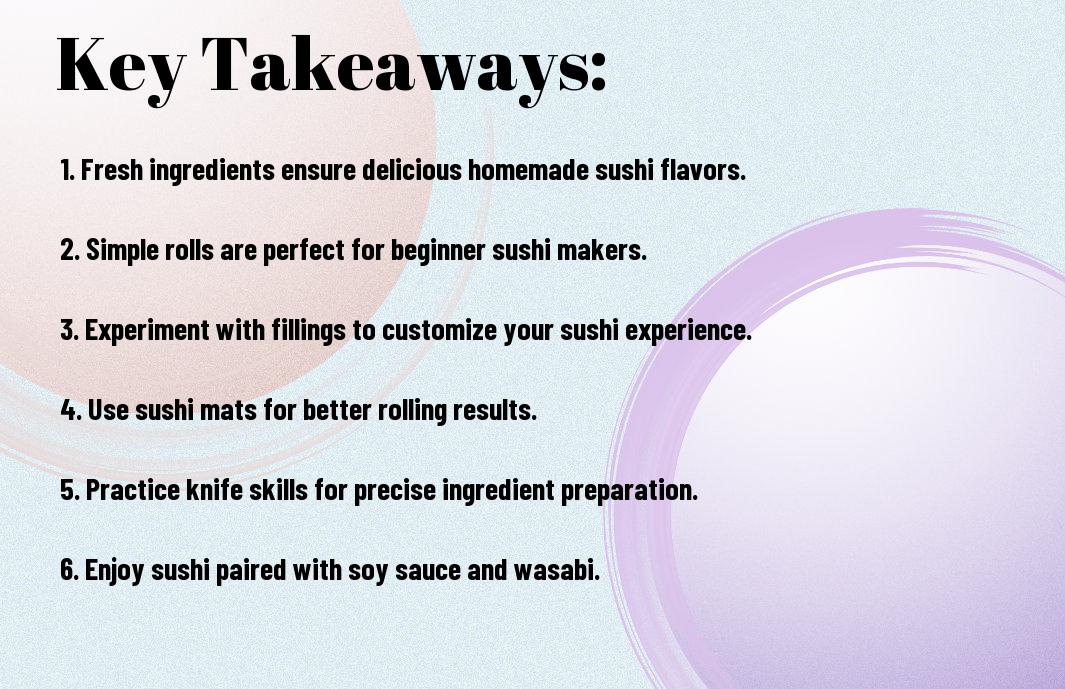
To wrap up
Conclusively, these 10 easy sushi recipes provide you with a fantastic way to experiment with sushi-making in your own kitchen. By trying your hand at these simple dishes, you can enhance your culinary skills and impress friends and family with your sushi creations. If you’re eager to explore more detailed techniques and recipes, check out the Best Sushi Recipes to Make At Home (How to Guide). Happy sushi-making!
Q: What are some vital ingredients needed to make sushi at home?
A: To create sushi at home, there are several key ingredients you’ll want to have on hand. These include sushi rice (short-grain rice seasoned with rice vinegar), nori (seaweed sheets), fresh fish or seafood (such as salmon, tuna, or shrimp), vegetables (like cucumber, avocado, and carrots), and various seasonings (like soy sauce, wasabi, and pickled ginger). It’s also helpful to have a bamboo sushi mat for rolling your sushi. These basics will set you up for success as you explore various sushi recipes.
Q: Are there any vegetarian sushi recipe options for those who don’t eat fish?
A: Absolutely! There are many delicious vegetarian sushi options that are easy to make at home. For example, you can prepare rolls using fillings such as cucumber, avocado, carrots, and bell peppers. Another popular vegetarian option is the shiitake mushroom sushi, where marinated mushrooms are used as the main filling. Furthermore, you can create a rainbow roll using a variety of colorful vegetables and fruits, such as mango or sweet potato, which add both flavor and visual appeal.
Q: How can I ensure my sushi rice is cooked properly for the best texture?
A: The key to perfect sushi rice lies in the cooking and seasoning process. Start with high-quality short-grain rice, rinsing it under cold water until the water runs clear to remove excess starch. Cook the rice according to the package instructions, typically using a rice cooker or stovetop. After cooking, let it sit covered for about 10 minutes to allow for even moisture distribution. Finally, gently mix the rice with a mixture of vinegar, sugar, and salt while it’s still warm, being careful not to mash the grains. This will yield a glossy and slightly sticky rice that’s perfect for sushi.
